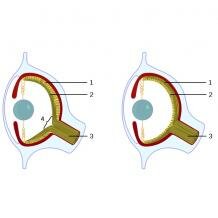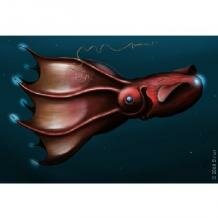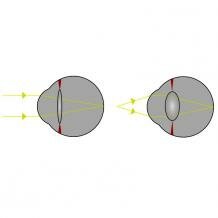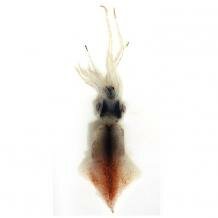Topic: Camera eyes of cephalopods
The remarkable similarity between the camera eyes of cephalopods and vertebrates is one of the best-known examples of evolutionary convergence.
Four classes of molluscs, the Gastropoda (snails and slugs), the Bivalvia (clams, mussels, and oysters), the Cephalopoda (octopuses, squid and cuttlefish) and the Polyplacophora (chitons), possess eyes. These eyes are extremely varied in structure as well as size, rendering molluscs one of the groups with the greatest morphological diversity in eye type. They range from simple pit eyes to compound eyes (e.g. in ark clams in the family Arcidae), pinhole eyes (e.g. in nautiluses in the genus Nautilus), reflector or mirror eyes (e.g. in scallops such as Pecten) and camera eyes. Camera eyes have evolved independently at least five times within the molluscs, four times in gastropods and once in cephalopods.
 Cephalopods are fast-moving predators that rely on vision for prey capture, predator detection and communication more than any other molluscs. It is thus not surprising that their eyes are the most specialised, providing excellent perception and visual acuity. The camera eyes of coleoids (that is all living cephalopods, excluding nautiluses) are remarkably similar to the camera eyes of vertebrates, in what is considered one of the most famous examples of evolutionary convergence. It has, however, been argued that “many of the convergent features that seem so remarkable (…) are inevitable, given a particular type and size of eye” (Land and Fernald 1992, Annual Review of Neuroscience, vol. 15, pp. 1-29). Furthermore, it should be mentioned, that the convergence has recently been doubted by some researchers, particularly after the discovery of Pax-6, a highly conserved gene that controls eye development across diverse lineages. Such evolutionary conservatism, however, needs to be put in a wider context. First, in cnidarians Pax-6 is not present, and eye development employs other Pax genes. Second, Pax-6 is used much more widely and is important in the development of other anterior neural structures, notably olfactory areas and also the brain. Finally, Pax-6 has been co-opted for non-nervous functions, most famously in the musculature of birds. Nobody would argue eye and muscle are homologous, would they?
Cephalopods are fast-moving predators that rely on vision for prey capture, predator detection and communication more than any other molluscs. It is thus not surprising that their eyes are the most specialised, providing excellent perception and visual acuity. The camera eyes of coleoids (that is all living cephalopods, excluding nautiluses) are remarkably similar to the camera eyes of vertebrates, in what is considered one of the most famous examples of evolutionary convergence. It has, however, been argued that “many of the convergent features that seem so remarkable (…) are inevitable, given a particular type and size of eye” (Land and Fernald 1992, Annual Review of Neuroscience, vol. 15, pp. 1-29). Furthermore, it should be mentioned, that the convergence has recently been doubted by some researchers, particularly after the discovery of Pax-6, a highly conserved gene that controls eye development across diverse lineages. Such evolutionary conservatism, however, needs to be put in a wider context. First, in cnidarians Pax-6 is not present, and eye development employs other Pax genes. Second, Pax-6 is used much more widely and is important in the development of other anterior neural structures, notably olfactory areas and also the brain. Finally, Pax-6 has been co-opted for non-nervous functions, most famously in the musculature of birds. Nobody would argue eye and muscle are homologous, would they?
Similarities with vertebrate eyes
Structure
 The cephalopod camera eye strongly resembles that of vertebrates (particularly fish), consisting of two chambers separated by a lens that projects an image onto the light-sensitive retina. The tissues show a close correspondence. The general structure of the retina, for example, is very similar, although the vertebrate retina is more sophisticated. In addition, at least cuttlefish show a change in retinal sensitivity as they grow, as do vertebrates. But the parallels do not end here. In both groups, the eyeball is located in a socket and rotated by extra-ocular muscles. Furthermore, the eye has a pupil (with an iris) that is equivalent to a shutter, controlling the amount of light that passes through the lens. It is capable of remarkably quick contraction, particularly in cuttlefish, where the pupillary response may be used in behavioural interactions. Remarkably, a pupil is also seen in the cubozoan jellyfish, and in nautiluses the aperture of their pinhole eyes (which lack a lens) acts as an adjustable pupil.
The cephalopod camera eye strongly resembles that of vertebrates (particularly fish), consisting of two chambers separated by a lens that projects an image onto the light-sensitive retina. The tissues show a close correspondence. The general structure of the retina, for example, is very similar, although the vertebrate retina is more sophisticated. In addition, at least cuttlefish show a change in retinal sensitivity as they grow, as do vertebrates. But the parallels do not end here. In both groups, the eyeball is located in a socket and rotated by extra-ocular muscles. Furthermore, the eye has a pupil (with an iris) that is equivalent to a shutter, controlling the amount of light that passes through the lens. It is capable of remarkably quick contraction, particularly in cuttlefish, where the pupillary response may be used in behavioural interactions. Remarkably, a pupil is also seen in the cubozoan jellyfish, and in nautiluses the aperture of their pinhole eyes (which lack a lens) acts as an adjustable pupil.
Lens properties
The lenses of both cephalopods and fish are hard and nearly circular. Lenses must be transparent, and crystallin proteins have been independently recruited for this purpose.  Crystallins represent an excellent example of molecular convergence. The lens of Gould’s squid (Nototodarus gouldi), for instance, contains only one class of crystallins, the S-crystallins, which are different from the crystallins found in vertebrates. However, their quaternary structure closely resembles that of vertebrate β-crystallins, and even an N-terminal amino acid sequence is analogous to sections of vertebrate crystallins. It has been suggested that these structural features might be necessary for lenses to function properly. The lens acts, of course, to focus light, but in a high-powered spherical lens there is the risk of spherical aberration, with the result that the image on the retina is blurred. Both cephalopods and vertebrates have solved the problem in exactly the same way. The refractive index of their lenses changes gradually from periphery to centre, due to different concentrations of crystallin. Thus, the lenses achieve high sensitivity and excellent imaging with relatively small eye size. In at least some squid, the lens allows for ultra-violet absorption, like in humans, where the lens contains an intrinsic UV filter.
Crystallins represent an excellent example of molecular convergence. The lens of Gould’s squid (Nototodarus gouldi), for instance, contains only one class of crystallins, the S-crystallins, which are different from the crystallins found in vertebrates. However, their quaternary structure closely resembles that of vertebrate β-crystallins, and even an N-terminal amino acid sequence is analogous to sections of vertebrate crystallins. It has been suggested that these structural features might be necessary for lenses to function properly. The lens acts, of course, to focus light, but in a high-powered spherical lens there is the risk of spherical aberration, with the result that the image on the retina is blurred. Both cephalopods and vertebrates have solved the problem in exactly the same way. The refractive index of their lenses changes gradually from periphery to centre, due to different concentrations of crystallin. Thus, the lenses achieve high sensitivity and excellent imaging with relatively small eye size. In at least some squid, the lens allows for ultra-violet absorption, like in humans, where the lens contains an intrinsic UV filter.
Performance
 The performance of cephalopod eyes resembles that of fish eyes with respect to speed, resolution and sensitivity. A study of visual acuity in some coleoids revealed that the optical capabilities of squid are comparable to that of other animals with presumably good vision (e.g. fish and birds). The visual acuity of the deep-sea vampire squid (Vampyroteuthis infernalis), a rather basal cephalopod, even rivals that of humans. This might be related to lens composition or the need to detect point sources of bioluminescence.
The performance of cephalopod eyes resembles that of fish eyes with respect to speed, resolution and sensitivity. A study of visual acuity in some coleoids revealed that the optical capabilities of squid are comparable to that of other animals with presumably good vision (e.g. fish and birds). The visual acuity of the deep-sea vampire squid (Vampyroteuthis infernalis), a rather basal cephalopod, even rivals that of humans. This might be related to lens composition or the need to detect point sources of bioluminescence.
Lateralised eye use and sleep
Octopuses have, of course, two eyes, but evidence now exists for lateralisation of use – one eye is preferred to the other. This convergent phenomenon is also found in, for example, dolphins and birds and in some cases associated with sleep (which itself has evolved many times).
Differences with vertebrate eyes
Structure
Despite all these similarities, there are some differences between cephalopod and vertebrate camera eyes. The eyes of some cephalopods lack a cornea, which is not disadvantageous, as the cornea plays no role in focussing in an aquatic environment (it has virtually the same refractive index as water). Furthermore, the cephalopod retina is everted, i.e. the distal ends of the photoreceptor cells are oriented towards the lens. Consequently, the connection between photoreceptors and the optic nerve is made behind the retina. In contrast, vertebrates have an inverted retina, where the photoreceptors lie behind transparent ganglion cells. This means that the optic nerve has to pass through the retina, resulting in a blind spot (which, accordingly, is absent in the cephalopod eye). The structure of the photoreceptors is also different, being rhabdomeric in the cephalopod eye and ciliary in the vertebrate eye.
Eye development
The developmental processes differ as well. While vertebrate eyes are outgrowths of the brain, forming from the neural plate that induces formation of a lens in the overlying epidermis, cephalopod eyes develop from epidermal placodes through a series of infoldings.
Accommodation
 Large camera eyes need a mechanism of accommodation, and cephalopods and terrestrial vertebrates have come up with different solutions. In cephalopods, focussing occurs through moving the lens, while terrestrial vertebrates change the shape of the lens (here, the cornea is involved in focussing as well). However, this difference can be considered merely a consequence of terrestrialisation and the accompanying change in the medium surrounding the eyes, as aquatic vertebrates use the same focussing mechanism as cephalopods.
Large camera eyes need a mechanism of accommodation, and cephalopods and terrestrial vertebrates have come up with different solutions. In cephalopods, focussing occurs through moving the lens, while terrestrial vertebrates change the shape of the lens (here, the cornea is involved in focussing as well). However, this difference can be considered merely a consequence of terrestrialisation and the accompanying change in the medium surrounding the eyes, as aquatic vertebrates use the same focussing mechanism as cephalopods.
Colour vision
 Most vertebrates possess colour vision, whereas cephalopods seem to be largely colour-blind (despite being highly adept at changing colour and blending in with their environment). One possible exception is the firefly squid (Watasenia scintillans), which has three visual pigments instead of only one. Interestingly, the firefly squid seems to have come up with a very different solution to the problem of chromatic defocus (image blurring due to different wavelengths having different refractive indices). Instead of multifocal lenses (that are present in fish and consist of concentric zones of different focal lengths that create well-focussed retinal images at different wavelengths) firefly squids possess a so-called banked retina, where photoreceptors of different spectral sensitivity are located at appropriate distances from the lens.
Most vertebrates possess colour vision, whereas cephalopods seem to be largely colour-blind (despite being highly adept at changing colour and blending in with their environment). One possible exception is the firefly squid (Watasenia scintillans), which has three visual pigments instead of only one. Interestingly, the firefly squid seems to have come up with a very different solution to the problem of chromatic defocus (image blurring due to different wavelengths having different refractive indices). Instead of multifocal lenses (that are present in fish and consist of concentric zones of different focal lengths that create well-focussed retinal images at different wavelengths) firefly squids possess a so-called banked retina, where photoreceptors of different spectral sensitivity are located at appropriate distances from the lens.
Polarisation vision
Some cephalopods are able to detect polarised light, what only some vertebrates such as birds can do (as well as insects, which have independently evolved this capacity). This sensitivity is mediated by the orthogonal orientation of neighbouring photoreceptors. As the common cuttlefish (Sepia officinalis) shows a prominent polarisation pattern on different body parts that changes with an individual’s behaviour, it has been hypothesised that polarisation vision might be involved in intraspecific recognition and communication.
Cite this web page
Map of Life - "Camera eyes of cephalopods"
https://mapoflife.org/topics/topic_7_camera-eyes-of-cephalopods/
March 4, 2021

